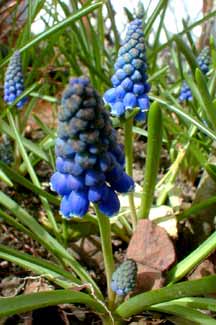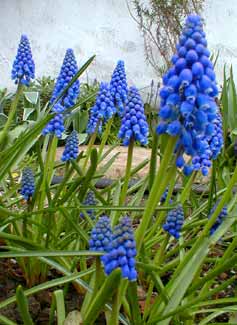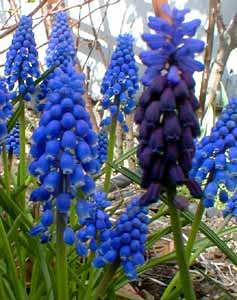
'Cote d'Azur'
Armenian Grape Hyacinth
"The hyacinth's for constancy wi' its unchanging blue,
And a' to be a Posie to my ain dear May."
-Robert Burns.
1759-1796
1759-1796
Muscari armeniacum 'Cote d'Azur' is a strain of Armenian Grape Hyacinth introduced in 1987 by C. van Bentem of The Netherlands. It was named for an especially beautiful region of Southern France, though the species is native not of Provence, but ranges from southeastern Europe to the Caucasus.
This named variety is purportedly a purer blue than the species, which normally veers into a shade faintly tingued with purple or violet. It is indeed a beautiful Cobalt or Royal Blue, but honestly the color distinction from that of the species isn't noticeable. Other cultivars including the unique powder-blue M. armeniacum 'Valerie Finnis' do have striking individuality, but 'Cote d'Azur' looks pretty much the same as any number of other named blues (including another we have for this species, M. armeniacum 'Dark Eyes').
In conditions it finds ideal, the species can occasionally be rampant, but many of the cultivars are not. I have no report on whether or not 'Cote d'Azur' has the rampant potential. As a rule, propogation of the cultivars is by bulb offsets, with some of them being entirely sterile & most self-seeding but poorly.
 It wants full morning or afternoon sunlight, but not both, & can usually do pretty well in light shade too. In autumn it produces bluish-green radiating leaves which are very winter hardy, undamaged unless the temperature drops to 5 degrees F. The leaves take a few years to begin forming really grassy clumps. It's an extremely close look-alike for M. botryoides likewise produces autumn/winter turf, but it is floppier & without the bluish tinge.
It wants full morning or afternoon sunlight, but not both, & can usually do pretty well in light shade too. In autumn it produces bluish-green radiating leaves which are very winter hardy, undamaged unless the temperature drops to 5 degrees F. The leaves take a few years to begin forming really grassy clumps. It's an extremely close look-alike for M. botryoides likewise produces autumn/winter turf, but it is floppier & without the bluish tinge.The flowers themselves for these two species are so extremely similar, both in appearance & in bloom time, that any garden already well-planted with either M. botryoides or M. armeniacum doesn't actually gain anything by adding the other, unless a cultivar much more individualistic than is 'Cote d'Azur.' If we'd realized beforehand that 'Cote d'Azur' doesn't actually have any unique qualities, we might've skipped it in favor of some other M. armeniacum cultivar, as we already had sufficient M. botryoides to last a lifetime.
 The progression of photos on this page show, at top, a large full mid-March bud not yet entirely blue but already quite stunning on a short stem. The second photo shows the flowers just at maturity. The third photo gives their look at the end of March & early April, when some of the sterile portion of flowers at the top of the pyramid of florets are fluffiest. The other flower in the third portrait is Muscari latifolium. Like other muscaries, it too has fluffier sterile flowers on top, but of such a different color that it has scored the common name Bicolor Grape Hyacinth.
The progression of photos on this page show, at top, a large full mid-March bud not yet entirely blue but already quite stunning on a short stem. The second photo shows the flowers just at maturity. The third photo gives their look at the end of March & early April, when some of the sterile portion of flowers at the top of the pyramid of florets are fluffiest. The other flower in the third portrait is Muscari latifolium. Like other muscaries, it too has fluffier sterile flowers on top, but of such a different color that it has scored the common name Bicolor Grape Hyacinth.Armenian Grape Hyacinth grows in zones 4 through 8. At the colder end of its zone tolerances it will flower in May, but on mild Puget Sound it has beautiful buds by mid-March, a few full flowers by the end of March, & continues flowery in April. The photo at top is from the third week in March, when the flowers were already quite large though not as fully fluffed out or as tall as they became a week later, as shown in the second photo.
In May this species produces green seed-pods that age to brown. These should be snipped off before they ripen to brown to insure maximum bloom power the following year. This will keep the potentially rampant wild species from spreading where it isn't desireable, & it will keep the far less fertile cultivars from wasting energy that would otherwise go to increasing the strength of each bulb & its offsets.
By the end of May or early June the grass dies back & the bulb remains dormant until about September, & during its dormancy conditions should be somewhat droughty. If it is necessary to lift & divide bulbs or transplant this muscari, when the grass dies back is a good time.
It grows eight to ten inches tall. The flowers are mildly fragrant, not noticeable unless one gets down close to smell them, but bees certainly notice. 'Cote d'Azur' has an additional value in that the bulbs are easily forced indoors for winter blooms, & make a remarkable contrast mixed with forcible crocuses or daffodils.